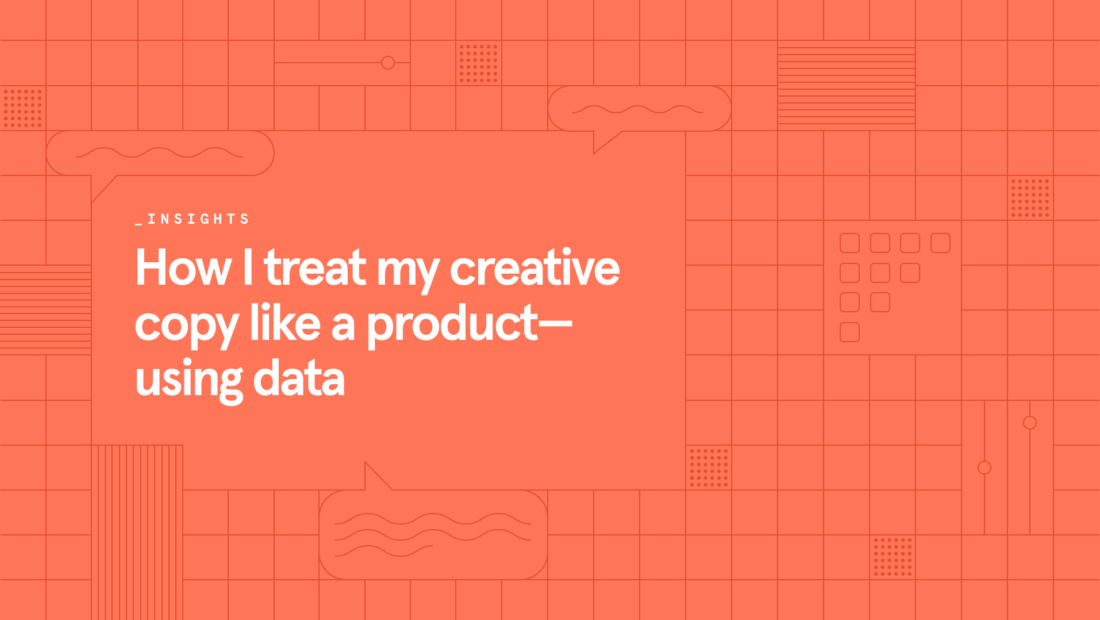
How I treat my creative copy like a product—using data

We’ve run dozens of customer interviews, analyzed our competitors, tracked our customer lifecycle, and aligned with the company vision: We’re now ready to… write copy.
If you think I’m being extreme, just wait until you read the rest of this post. Copywriting, while often thought of as something creative and inspired, is a technical craft. It’s absolutely rooted in the empirical data that gives an objective understanding of your customers’ paint points and desires. It’s a product unto itself.
And just like a product process, you need data to create something great. From customer research to monitoring and iteration, good copywriting is rooted in data. Here’s how I think about it.
Start with customer research
I consider myself a “conversion-copywriter.” Coined by Joanna Wiebe, conversion copywriting is “data-driven copy that gets prospects and visitors to say yes.” It’s a scientific study in human psychology and empathy, the science of knowing what words will help people understand and connect with your brand and product. You wouldn’t build a product without doing customer research and validating your idea. Don’t write marketing copy without understanding the customer and their pain points.
To get it right, you’ve got to run research to figure out what needs to be said.
Qualitative research tell you why people do things
If you know a thing or two about product development, you’ve heard of the “a-ha” moment. It’s the “pivotal moment when a new user first realizes the value of your product and why they need it,” according to Appcues. It’s also a moment when someone is likely to signup and/or buy your product. Product and growth managers often build onboarding flows that get users to this moment fast. The same is true with marketing collateral.
Since conversion copywriting “gets to a yes,” it has to keep in mind one specific goal. That goal is the “a-ha” moment. If I’m creating a funnel for a product (ad, sales page, email follow-up) the goal of every word on every piece of collateral is to get readers to this one moment because it’s also the moment of conversion. Conducting interviews with users on what “aha” could be for them is a good starting point.
Here’s more on my qualitative customer interview process.
Keyword research
As I’ve seen it applied, most keyword research is used to create a laundry list of blog posts to create words to fit into a sales page, so Google Search prioritizes your work. And while this isn’t bad, it forgets that keyword research is a study of language.
Forest through the trees, keyword research answers: What words do people use to describe the pain point your product solves—at scale? It can be incredibly insightful for early-stage companies to establish their positioning and product-market fit.
For example, if you’re a company like doola, it’s important to know if your audience is searching for “start a US bank account” or “form an LLC” as you build your initial inbound funnels. While doola does both, understanding how customers think about their paint point and what they type in Google to find a tool like yours is key.
Parse customer-created copy for repeated phrases
Another way to quickly understand how your customers talk about your product and what they care about is to analyze all the places they talk to you. Think: TrustPilot reviews, customer support tickets, and ProductHunt comments.
I often sort through these and copy and paste repeated phrases into a voice-of-the-customer database. Through this, I start to understand how people talk about products, what they like, love, or aren’t aware of.
Depending on the project, I might also pull keywords from competitor pages, look at Google Trends, or dive deeper into online communities to learn more about a customer.
Quantitative research tells you what people are doing
I like to say that quantitative research tells you what’s going on, and qualitative research tells you why. When focusing on the quantitative aspects of copywriting, I like to use funnel data in Mixpanel to understand where customers engage and break off during their lifecycle. Paired with the research you see above, you can get a sense of what people do and don’t understand about your product when they hit certain pages.
For me, it answers: Where are people falling off? Are they getting to the “aha” moment? What don’t they understand? What needs to be said to help customers understand the value of a product? Wherever you see a hole in your funnel is a good place to dive in with conversion copywriting.
I like the funnels tool best for this because it helps you empirically understand a user journey. It also stops you from making common mistakes like focusing on pages that people don’t read. For example, I recently worked on a blog conversion project. It seems inherent that we would start by redoing the blog homepage. But! When we looked at how people interact with the brand, we found that most people read a blog post and move directly to a product page, which meant we’d make more gains by focusing on optimizing these pages over the blog homepage.
Merge research-backed copy with company strategy
Product people like to quote Henry Ford saying “If I had asked people what they wanted, they would have said faster horses.” And while we’ve just done extensive customer research, the best copywriters know how to artfully blend what customers are currently saying with a company’s vision of itself in the future. You’ve got to blend message matching from your research with a glimpse of where the product will go or what inspires an audience.
I hesitate to give this advice because I worry it gives founders or CEOs free rein to write things like “just do it” on their homepage hero. High-concept tag lines and key messaging are useful, but they don’t make sense on a homepage because they don’t tell people what you do. If you’re an early-stage startup, clarity is key.
My rule of thumb is this: If you’re seed stage or series A, tell people exactly what you do and how. If you’re series B and beyond, do this but also artfully and competitively. It’s important to merge voice-of-the-customer research and also lead readers to the magic of your app.
If this is feeling a little “pull copywriting out of a black hat,” let’s ground it in some tactical approaches. Oftentimes, apps are The Stripe of X, or the PayPal of X; they’re an analogous tool in a new industry. So, use the Wayback machine to understand how similar products disrupted a market.
I love looking at Plaid’s history. It’s incredibly consistent. Plaid has always been a modern API for banking data for developers. They’re crystal clear that they speak to and for developers. It’s only after their acquisition that they broadened their audience and value prop.
Plaid’s homepage on March 15, 2015
Plaid’s homepage on February 11, 2017
Plaid’s homepage today
Tie research to the stages of the customer lifecycle
Once you’ve done the research, you have to make sense of it and figure out how to use it. I like organizing research by stages of decision-making.
Let’s use Wally as an example. I break down research by questions:
- How do customers describe Wally (or what words would they search for in Google)?
- What are your customer goals (or what needs to be in the copy to get people to the homepage and through signup)?
- Why are they interested in Wally (or what’s the pain point that needs to be solved in the homepage hero)?
- What are some competitors (or who might customers have already Googled…)?
- Why do they sign up?
- What is the “aha” moment?
- When are they willing to pay?
- Why do they engage or go inactive?
Through this, I start to understand how people talk about products at every stage of the lifecycle. An unqualified lead calls Wally a “crypto wallet,” and we need to be searchable in those conversations to be found (yes, even if that’s not exactly what you do). Once you’ve met people where they are, you can shift the conversation as you qualify new leads and get them to a lower stage. For example, someone who is considering Wally is going to use words like “elegant onboarding flow for Web3,” and someone ready to buy talks about “gas tanks.”
How does that impact writing? While an ad might discuss a crypto wallet, a homepage might talk about an onboarding flow, and the email might talk about the aha moment and mention gas fees.
Apply the research
Ready to write? After all of this research, you’ve finally got the knowledge you need to build your product write about your product.
With research organized by the stages of the lifecycle, you know your customers’ stage of awareness on each property, and with “aha” user interviews, you know exactly where you need to take their understanding.
Now, it’s time to write. Art time? Nope. Remember all that voice-of-the-customer research you pulled? We’re going to repeat and reuse these phrases across our properties. This technique is called message matching. It’s the asynchronous version of mirroring. If you want someone to immediately see themselves in your copy, to get it, and think, “That’s me!” then you want to incorporate the language they use into your messaging.
Now, do this and try to get a few SEO keywords into your H1s and H2s. Then, make it sound human and elegant. Conversion copywriting is basically a big word sudoku puzzle. Copy fits the needs of the customers and the business, much like any product must do.
Ensure you have monitoring tools in place
And if you thought it was time to ship a page, I’m sorry to disappoint you. There’s one more step of a sound copywriting process: monitoring. Since we treat copy like a product, it means we have to understand how it performs.
Let’s start with event tracking through something like Mixpanel or Google Analytics. If you don’t know where people are clicking on your page or through your signup flow, you’ve got very little insight into how to increase conversion rates. However, having been on marketing teams for eight years, I know firsthand how difficult it can be to get this event tracking implementation work prioritized by engineering teams.
There are a few options there. You could learn to do it yourself. Really! It’s not difficult to learn basic command line functions to be able to implement event tracking yourself. As a bonus, once you’re able to ship changes like this, you can also quickly edit copy as needed if your team isn’t using a tool like Webflow. Alternatively, there is a slew of tools being built to make this process as easy as using a tool like Squarespace. Teams like Freshpaint make adding event tracking to your site a WYSIWYG process.
Luckily, from here, monitoring gets a lot easier. I like tools like HotJar to understand when and how someone interacts with the page. Google Analytics is great for understanding bounce and time on a page. And then you’ve got great tooling within most email service providers to review open rates and click through. Look at all of these to determine how copy is performing.
Iterate on your copy like you would with your product
Like with any product, copy is a living thing. Once it’s out in the world, you’re going to learn a lot about how to make it better.
When I scope a project, I also include “iteration and review” or a check-in point 4-6 weeks out from launch where teams and I review how copy is performing and then optimize it. Even with all of the research we’ve done, there’s nothing like seeing how a subject line performs and running a quick A/B test.
Email tools make this incredibly easy, but it gets a bit harder with landing pages. Do you pay for Google Optimize, or do you build something yourself? Personally, I’ve gotten a lot out of using Mixpanel with A/B testing tools. With companies who have the Segment/Mixpanel stack, event tracking is the same between your data warehouse and what you can see in Mixpanel. It’s quick to create cohorts and dashboards for new launches.
One of the nice things about copywriting is that it’s easy to change and update. Quickly push changes, make note of when those changes happened in your analytics tools, and watch how signups and purchases change.
Conclusion
Through this process of research, application, and iteration, you land on copy that adds to your product experience. It sounds great, sure, but it’s also research-backed and going to help with conversion rates through your funnel. It’s treating copywriting like a product that makes it feel like one.
About Ashley Hockney
Ashley is a growth and marketing consultant with a focus on copywriting. She was previously the Director of Marketing at Buffer and an early hire at Codecademy and Zapier. Looking for more customers? You can work with her here.





